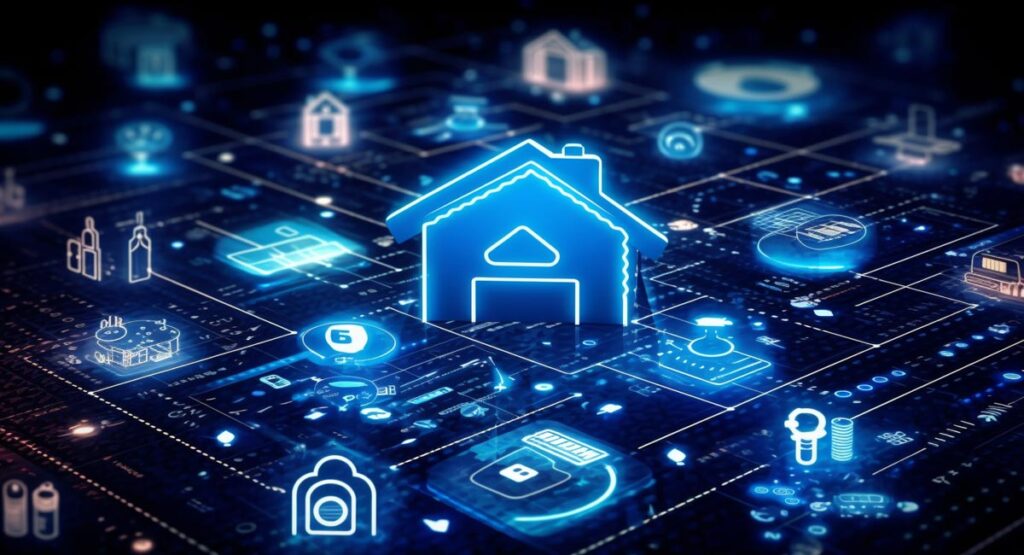IoT Security, imagine a world where your refrigerator can order milk for you when you run out, your thermostat learns your daily routine and sets the temperature to your liking, and your car starts itself on a cold winter morning. This isn’t a sci-fi movie—welcome to the world of the Internet of Things (IoT). But with great connectivity comes great responsibility. Are these devices safe? What happens if someone unauthorized gains control? Dive in as we unwrap the layers of IoT security.
IoT Security: Ensuring a Safe Digital Future
Table of Contents
- What is the Internet of Things (IoT)?
- Why is IoT Security Essential?
- Common IoT Security Threats
- Best Practices for IoT Security
- The Future of IoT Security
- Frequently Asked Questions
- Final Thoughts
What is the Internet of Things (IoT)?
The Internet of Things (IoT) sounds like a term ripped straight out of a science fiction novel, doesn’t it? But, peel back the layers of jargon, and it’s a surprisingly simple, yet transformative concept. In essence, IoT is all about connectivity, data, and the power of networks.
Defining IoT
At its core, the Internet of Things refers to the interconnected nature of devices and systems that communicate with each other over the internet. Think about it. It’s not just your phone or laptop anymore. Today, everything from your watch to your refrigerator, your thermostat, and even your car can be networked to the internet. These devices, equipped with sensors, software, and other technologies, are designed to collect and exchange data, making them smarter and more aware of their environment.
Examples in Daily Life
To truly grasp the depth of IoT, consider these daily scenarios:
- Your alarm goes off in the morning and sends a signal to your coffee machine to start brewing.
- Your refrigerator detects you’re running low on some items and places an order for delivery or alerts you via a mobile app.
- Streetlights in cities that adjust their brightness based on the time of day or movement detected, conserving energy.
Beyond Household Gadgets
But IoT isn’t restricted to just consumer gadgets. It has a profound impact on industries and broader societal systems:
- Healthcare: Medical devices can monitor patient vitals and notify healthcare professionals in real-time if there are any abnormalities.
- Agriculture: Sensors in fields measure moisture levels, helping farmers know when to irrigate.
- Transportation: From smart traffic management systems that adjust signal timings based on traffic flow to connected cars that can alert drivers about upcoming hazards or traffic jams.
The Data-Driven Evolution
The power of IoT truly comes alive with data. With billions of devices collecting, sharing, and interpreting data, we’re now able to make more informed decisions. Whether it’s a thermostat learning our heating preferences and adjusting accordingly or a manufacturing plant predicting when a machine is likely to fail and conducting maintenance preemptively, the ramifications are profound.
The Internet of Things is more than just devices talking to each other. It represents a world where physical objects come alive with intelligence, reshaping how we live, work, and interact. This isn’t just the future; it’s the present, quietly humming in the background of our interconnected lives.
Why is IoT Security Essential?
Where devices outnumber people and our reliance on interconnected technologies has never been greater, security in the IoT realm isn’t just important—it’s imperative. But why does IoT security carry such weight? Let’s delve deeper into the intricacies of this pivotal question.
The Vulnerability of Interconnectivity
At its heart, IoT is about connection—devices linked to each other, networks, and the wider internet. But every connection point is a potential vulnerability. Without stringent security measures, every added device is a new door left ajar for malicious entities.
Rising Stakes with Personal Data
Many IoT devices are reservoirs of personal data. Consider wearables that track our heart rate, smart assistants that record our preferences, or even smart cameras that monitor our homes. A breach doesn’t just risk data—it risks deeply personal insights into our lives.
The Scope and Scale of Threats
With traditional computing systems, threats, while significant, were somewhat contained. With IoT, the scale is staggering. It’s estimated that there will be 30 billion connected devices by 20251. The very scale of these networks means that the potential fallout from even a small vulnerability can ripple across millions of devices and systems.
Infrastructure and Public Safety
Beyond personal devices, IoT is increasingly interwoven with critical infrastructures. Whether it’s smart grids managing electricity distribution, interconnected transportation systems, or healthcare devices, a security lapse can have grave real-world consequences. Can you imagine the chaos if traffic management systems were hacked or if a city’s power grid was maliciously shut down?
Trust in Technology
For technology to be embraced, it must first be trusted. Without rigorous IoT security, consumer and enterprise trust in these technologies can erode. This not only affects adoption rates but could stall the very innovation that drives the sector.
Economic Implications
A security breach doesn’t just have immediate fallout—it can have long-term economic consequences. Companies could face reputational damage, loss of customer trust, and even significant financial penalties. In a world increasingly driven by data, ensuring that data remains secure is paramount.
IoT security isn’t a mere technical consideration—it’s a lynchpin that holds together the fabric of our digital future. As devices become smarter, networks more expansive, and our reliance on these systems deepens, ensuring they’re secure isn’t just a priority, it’s an absolute necessity.
Common IoT Security Threats
As the proliferation of IoT devices continues, so too does the expansion of the threat landscape. With a myriad of devices interconnecting, exchanging data, and automating tasks, vulnerabilities become potential goldmines for malicious actors. Let’s take a deeper dive into the threats looming in the IoT space.
Device Spoofing
Think of device spoofing as an imposter pretending to be your trusted device. Malicious entities can mimic IoT devices, gain unauthorized access, and participate in networks as legitimate members. This deception allows them to intercept data, send malicious commands, or sabotage network functions.
Man-in-the-Middle Attacks (MitM)
In the world of cyber threats, the man-in-the-middle is the ultimate eavesdropper. As data gets transmitted from one IoT device to another, attackers insert themselves into the communication channel, intercepting, altering, or even redirecting the data flow. The implications? Stolen data, corrupted commands, and breached privacy.
Physical Attacks
While often overshadowed by their digital counterparts, physical threats are very real in the IoT universe. Devices can be tampered with, damaged, or even stolen, leading to data breaches, system interruptions, or hardware manipulation.
Eavesdropping and Surveillance
Many IoT devices, especially consumer ones like smart cameras or voice assistants, can be turned into unintended surveillance tools. By exploiting vulnerabilities, cybercriminals can gain unauthorized access, silently turning devices into spies within one’s own home or organization.
Distributed Denial of Service (DDoS) Attacks
The sheer number of IoT devices makes them an attractive target for orchestrating large-scale DDoS attacks. Compromised devices are turned into ‘zombies’ that flood servers with overwhelming amounts of traffic, causing them to crash and disrupt services.
Insecure Network Services
Many IoT devices connect via insecure networks or utilize weak communication protocols. This leaves them vulnerable to attacks, where cybercriminals can exploit these weak points to infiltrate systems, launch attacks, or siphon off data.
Inadequate Software Maintenance
Lack of regular software updates or the inability to patch known vulnerabilities turns IoT devices into sitting ducks. Outdated software can be exploited, and since many devices operate autonomously, users might be oblivious to ongoing breaches.
Supply Chain Threats
The very lifecycle of an IoT device offers opportunities for infiltration. From design to production to deployment, vulnerabilities can be introduced at any stage, sometimes even before the device reaches the end-user.
The dynamic nature of the IoT landscape means that while these are some of the prevalent threats, the list is continually evolving. As devices become more sophisticated, so too will the methodologies employed by cybercriminals. Understanding these threats is the first step in fortifying defenses and ensuring the promise of IoT isn’t overshadowed by its potential perils.
Best Practices for IoT Security
With IoT, the line between innovation and vulnerability is thin. While IoT devices promise enhanced efficiency and convenience, they can also open the door to significant threats if not secured properly. Thankfully, with proactive steps and best practices, the risk can be mitigated. Let’s delve into the essential practices to keep IoT deployments secure.
Regular Updates and Patches
Just as we need our regular health check-ups, IoT devices need consistent software updates. Manufacturers often release patches to fix known vulnerabilities. Ensure that all your devices are set to update automatically or establish a routine check for updates.
Change Default Credentials
Out of the box, many IoT devices come with default usernames and passwords. These are a hacker’s delight. It’s crucial to change these default credentials immediately upon setup. And don’t just stop there—establish a routine to update your passwords periodically.
Network Segregation
Picture this: your IoT devices as guests at a party, and your network is the venue. Would you mix all guests together, or group them based on some criteria? By segregating your devices across different networks, if one network is compromised, the damage doesn’t spread everywhere.
Enable Multi-Factor Authentication (MFA)
Two is better than one, especially in security. MFA requires users to provide two or more verification methods to gain access. This could be something they know (password), something they have (a smartphone app), or something they are (fingerprint).
Device Management and Inventory
It’s simple—know what’s on your network. Regularly update your inventory of connected devices. When devices are no longer in use, or become obsolete, ensure they are properly decommissioned and removed from your network.
Limit Device Permissions
Not all devices need to perform all functions. Limit each device’s permissions to only what’s necessary for its specific function. This principle of least privilege reduces the potential damage of a breach.
Use Secure Communication Protocols
Data in transit can be a prime target for attackers. Always ensure that your IoT devices use secure, encrypted communication protocols, like SSL/TLS, to prevent unauthorized data interception.
Implement Physical Security
Beyond cyber threats, remember that IoT devices are susceptible to physical tampering. Implement physical security measures, such as locking devices in secure locations or using tamper-evident seals, especially for critical devices.
Educate and Train
A well-informed team is one of the best defenses against security breaches. Regularly train your team on the importance of IoT security, potential threats, and best practices.
Collaborate with Manufacturers
Finally, remember that security is a two-way street. Collaborate closely with device manufacturers and vendors. Stay informed about potential vulnerabilities, patches, or recalls. The more informed and proactive you are, the better you can protect your IoT ecosystem.
The Internet of Things holds immense promise, bringing intelligence and interactivity to even the most mundane devices. However, without robust security practices, this potential can be overshadowed by risks. By embedding security at every level—be it at the device, network, or user level—you ensure that you reap the benefits of IoT without compromising safety.
The Future of IoT Security
Peering into the future of IoT security, it’s a blend of challenges met with burgeoning technological advancements. The sheer scale of IoT and its deepening integration into our lives means that its security landscape will continue to evolve rapidly. So, what does the future hold?
Emergence of AI and Machine Learning
As threats become more sophisticated, traditional defense mechanisms may fall short. Enter Artificial Intelligence (AI) and Machine Learning (ML). These technologies can analyze vast amounts of data from IoT devices in real-time, detect anomalies, predict vulnerabilities, and even autonomously counteract threats. The security systems of the future will not just react; they will proactively defend.
Quantum Computing and Encryption
On one hand, quantum computing promises unparalleled computational power, which can be leveraged for enhanced security protocols. On the other, this very power could challenge current encryption methods. The future will witness a race: as quantum computing evolves, so too will quantum-resistant encryption techniques.
Decentralized Security Systems
The centralized nature of many current IoT systems can be a vulnerability. The future might see a shift towards decentralized architectures, like blockchain, where data integrity is maintained across a distributed network. This can significantly reduce the risk of single-point failures and data tampering.
Regulation and Standardization
As the implications of IoT security breaches become more profound, governments and international bodies will inevitably step in. Expect to see stricter regulations, industry standards, and best practice guidelines being established, ensuring manufacturers and users adhere to stringent security norms.
Edge Computing for Enhanced Privacy
Edge computing refers to processing data closer to where it’s generated (i.e., on the device itself) rather than in a centralized cloud-based system. This minimizes the amount of data transmitted, reducing exposure to potential interception and enhancing user privacy.
Integrated Security Design
Rather than being an afterthought or an additional layer, security will be integrated into the design phase of IoT devices. Manufacturers will adopt a “security by design” approach, where devices are built ground-up with security at their core.
User Awareness and Control
As IoT devices become an integral part of our lives, users will demand greater transparency and control. The future will likely see devices equipped with more user-friendly interfaces that provide clear information about data usage, sharing, and security settings.
Collaborative Threat Intelligence
Expect a rise in platforms and ecosystems where organizations, manufacturers, and even nations share threat intelligence. This collaborative approach will ensure quicker responses to new vulnerabilities or emerging threats.
The road ahead for IoT security is undeniably challenging, marked by an ever-evolving array of threats. However, with the confluence of advanced technologies, regulatory efforts, and increased user awareness, the future holds promise. The goal? A world where the transformative potential of IoT can be harnessed without compromising on security and privacy.
Frequently Asked Questions
Final Thoughts
The mesmerizing realm of IoT holds the promise of a connected and efficient future. However, like a coin with two sides, it comes with its challenges. The key takeaway? While enjoying the luxuries of smart devices, never compromise on security. It’s the bridge between a dreamy future and a dystopian one.
I write for and assist as the editor-in-chief here on Host Screamer. I’m a digital entrepreneur since 1992. Always Keep Learning! Notice: All content is published for educational and entertainment purposes only. NOT LIFE, HEALTH, SURVIVAL, FINANCIAL, BUSINESS, LEGAL OR ANY OTHER ADVICE. Learn more about Mark Mayo





